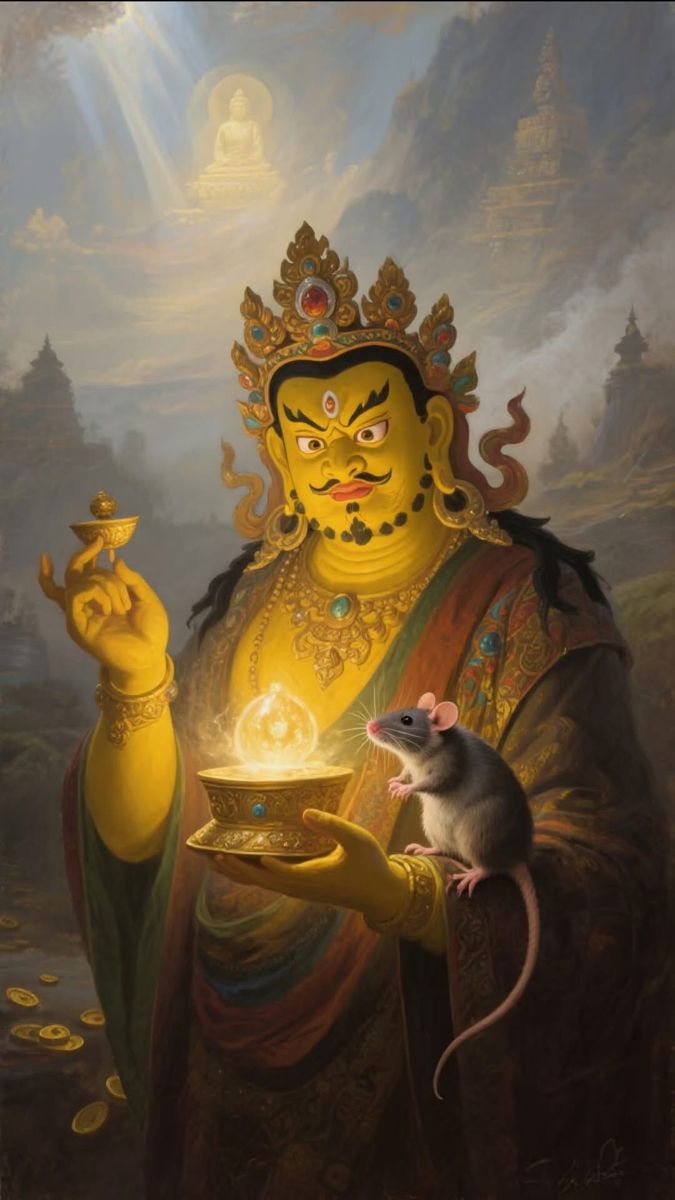
Yellow Jambhala Thangka: The Tibetan Wealth Deity’s Ancient Wisdom, Why It’s a Modern Spiritual Amulet
I. Yellow Jambhala: From Bodhisattva to “Top of the Five Wealth Deities” (A 1,000-Year Evolution)
In Tibetan Buddhism’s pantheon of wealth deities, Yellow Jambhala (Tibetan: “Zambhala Serpo”) is far more than a symbol of money—his origin carries a millennium of spiritual heritage. Legend says he began as a fully enlightened bodhisattva. When Buddha Shakyamuni taught the Great Perfection Sutra at Vulture Peak, demons caused earthquakes to disrupt the gathering. Jambhala stepped forward to protect the disciples; in response, Buddha tasked him with safeguarding Buddhism and helping the poor—eventually making him a major protective deity in Vajrayana (Tibetan) Buddhism.
His image also tells a story of cultural fusion: Jambhala first appeared as a god in ancient Hindu Brahmanism. After entering Buddhism, he became associated with Vaisravana (one of the Four Heavenly Kings, guardian of wealth). In Tibet, his role as a wealth keeper was amplified, and he rose to lead the “Five Dhyani Buddhas of Wealth” (alongside green, white, red, and black Jambhalas). Even in Yuan Dynasty (13th–14th century) cave art (e.g., Alxa Gobi’s Arzhai Grottoes), he was depicted as an incarnation of Genghis Khan—blending spiritual authority with earthly power, a testament to his importance.
II. Yellow Jambhala’s Core Powers: More Than “Bringing Money” (3 Key Blessings)
Reducing Jambhala to a “money-giving god” misses his deeper spiritual meaning. According to Tibetan Buddhist scriptures, his powers offer both material and mental gifts:
- Wealth Mastery: As the “guardian of all treasures,” he holds a wish-fulfilling jewel (symbolizing universal abundance) in one hand, a mongoose (which spits out jewels, representing endless prosperity) in the other, and stands on a conch shell (a sign of “retrieving wealth from the ocean”). Followers believe he directly improves financial luck and eases money struggles.
- Vitality & Longevity: Beyond material wealth, he boosts overall well-being. Believers in Repkong (Regong) in Qinghai Province (a renowned Thangka art center) say wearing his Thangka strengthens health and wards off illness.
- Mindful Purity: His teachings emphasize “overcoming greed and stinginess.” Practitioners are encouraged to cultivate compassion (“bodhichitta”) and generosity—finding inner peace while seeking prosperity, rather than chasing money blindly.
III. Wearing a Yellow Jambhala Thangka: Visible Benefits & Invisible Nourishment
A Thangka (a portable Tibetan Buddhist scroll painting, often called a “mobile temple”) with Yellow Jambhala carries layered meaning:
- Practical Help: Business owners hope it brings “prosperous sales”; office workers pray for “income growth.” At Chengde Puning Temple (a major Tibetan Buddhist site in China), annual Jambhala ceremonies draw crowds seeking career luck.
- Emotional Comfort: Amid modern financial stress, the Thangka acts as a “spiritual anchor.” Followers at Shaanxi Guangren Temple (a key Tibetan Buddhist temple in Xi’an) share that touching Jambhala’s image on the scroll eases anxiety.
- Karma Accumulation: Tibetan Buddhism teaches that wearing the Thangka with respect—and practicing generosity (e.g., donating to charity)—builds “merit” (positive spiritual energy), not just monetary gain.
Note: Traditional guidelines apply: Non-Buddhists should seek guidance before wearing it; avoid wearing it in angry or disrespectful moments; and never use it for selfish greed—legend says such behavior severs its protective blessings.
IV. Who Wears Yellow Jambhala Thangkas? 3 Key Groups & Their Reasons
- Career Builders: Entrepreneurs and investors are the largest group. Data from Tibet Zanglu Thangka (a leading Thangka brand) shows 70% of Yellow Jambhala Thangka buyers are startup founders—they value its “career protection” meaning.
- Culture Enthusiasts: Thangka masters in Repkong note that many 非遗 (intangible cultural heritage) lovers collect Yellow Jambhala Thangkas. Hand-painted with mineral pigments (e.g., gold, lapis lazuli), each scroll is a “living cultural relic.”
- Spiritual Practitioners: Vajrayana Buddhists use the Thangka as a meditation tool. They chant Jambhala’s mantra (“Om Zambhala Dzaya Soha”) daily, believing it aligns their intentions with the deity’s compassion.
V. Why Choose a Thangka? 3 Core Values (Beyond Ordinary Jewelry)
In a world filled with Buddha pendants and prayer beads, Thangkas stand out for 3 reasons:
- Faith Made Tangible: Unlike mass-produced jewelry, Thangkas require artists to chant prayers while painting; lamas (Tibetan Buddhist teachers) “bless” them afterward. At Shaanxi Guangren Temple’s Thousand Buddhas Hall, each Yellow Jambhala Thangka holds Tibetan herbs and scriptures—seen as “living sacred objects.”
- Cultural Heritage: A Yellow Jambhala Thangka fully shows his classic image (golden body, bare chest, holding treasures, standing on a conch)—symbols that reflect Tibetan Buddhism’s views on wealth (abundance for good, not greed).
- Timeless Appeal: High-quality Thangkas grow more radiant with time. As followers say: “The Thangka nourishes you, and you nourish the Thangka—wealth and inner growth both deepen with years.”
Conclusion: The True Meaning of Worshiping Jambhala
The popularity of Yellow Jambhala Thangkas is not “superstition for money”—it’s modern people’s desire for both “material security” and “spiritual fulfillment.” A Tibetan proverb sums it up: “Jambhala does not bless the greedy.” Wearing the Thangka is a reminder: The ultimate value of wealth is using it to become a better person—and help others.





